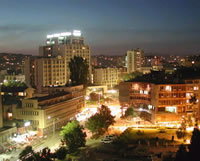
PristinaSince 1981, there has been no census in Kosovo. After the war, Pristina is overpopulated. Many figures, but based on the analysis and the number of voters, the number of people residing within the city, could be approximately 400 thousand, and 470 villages , is envisaged that the move to 500 thousand citizens . During all periods of history, the Balkans and Central East he was and continued to be the most dynamic areas of ethnic and social movements of the historical and political events. For this reason, the change occurred in ethnic and religious structure.
Because of this, mostly ethnic indigenous population suffered Illyrian, Thracian and Macedonian well. In the whirlwind of these events, there is also the space where today lies Pristina. Traces of residence in the capital of Kosovo, we find that the pre-ever support archeological locations found in the Early Neolithic, as Matican, Gracanica, etc. Ulpianë., Then in the Bronze Age, to the Ethno-culture Dardanian since centuries. VIII and VI before Crist.According to historical data written to c. XIV, for Pristina have little data and fragmentary. Thus, the structure of Pristina can not rely only on data from short narrative archive of Ragusa (today Dubrovnik), for the period paraosmane unused and Turkish documents consulted.
The first written Pristina is the year 1342 by the Byzantine Emperor, Johan Kantakuzen which describes Prishtina as a village. After this year, it is likely that there was St. Mary's Catholic Church and as priests mentioned the names, like the Albanians Don Lasio,existed during the old city of Ulpiana (Ulkiana), while during the early Middle Ages the city Zlatnic miners, then investigate that until the time of Ottoman rule, has not had a significant role in the century. XIV and XV when Pristina, capital of Kosovo today begins to develop as an important commercial center.CultureAs the capital of Kosovo is the center of cultural and artistic of all Albanians living in Kosovo. Directorate of Culture of the Municipality of Prishtina is a segment that cares only for important cultural events that Pristina today rank among the cities that has a tradition of emphasizing cultural and artistic. Library "Hivzi Sylejmani" established 60 years ago is now in its drawers over 70 thousand books in all languages of the world.
Only in Pristina, it also has four other branches located in most major neighborhoods of the city, so that the book is as close to the reader. There are also nine other branches of the library distributed in rural parts of the city and, in the village Bardhosh, Lugar, Keçekollë, Colic, Hajvali, Gracanica, Laplje Selo, Sushice of Čaglavica (the latter mostly populated by Serbs). Cultural heritage is a special chapter reflects the antiquity of Pristina as administrative and cultural center, Dardania from 3500 BC to the present day.In Pristina Museum found the statue of the Queen of Dardania. In the last fight, this statue by Serbian police and was taken to Belgrade, until this year, UN envoy in Kosovo, Michael Steiner turned it from Belgrade to Kosovo Museum in Bath Prishtinë.Në found Perishtinë City, Emin Gjika House, in which it is situated Academy of Sciences and Arts. Pristina has its archive, which was founded in the fifties of the last century and retains the entire archive fanaticism of the city and surrounding region Pristina.
From (34) tcultural and artistic societies that vivify the musical in Pristina, will separate association "Bajram Curri", founded in 1963, Song and Dance Ensemble of the University of Pristina was established in 1962, Choir "Colegium cantorum "established in 1963 and other cultural and artistic activities, which enrich the cultural life in the capital of Kosovës,event that is separate establishment of theater" Dodona "in 1986 and Kukullave.Dikur Theatre, Pristina had four cinema halls, while today there is only one and it operates within the company for the screening "Genc". Among the most important projects of the Youth Pristina remains with space of over 20,000 square meters.
In the center of Pristina is set Skanderbeg monument, Zahir Pajaziti and Mother Teresa.



